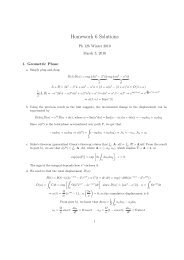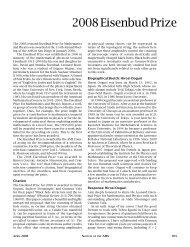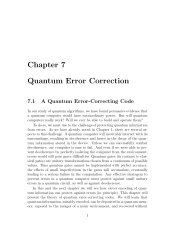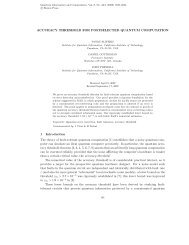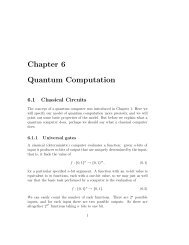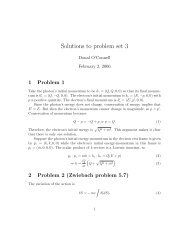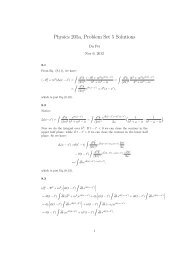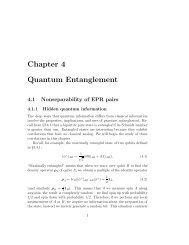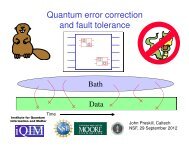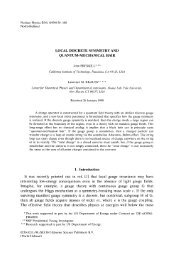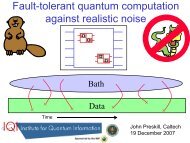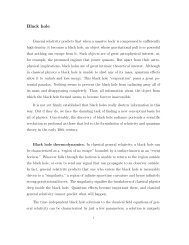Create successful ePaper yourself
Turn your PDF publications into a flip-book with our unique Google optimized e-Paper software.
<strong>Ph219</strong>/<strong>CS219</strong> <strong>Problem</strong> <strong>Set</strong> 3<br />
Solutions by Hui Khoon Ng<br />
December 3, 2006<br />
(KSV: Kitaev, Shen, Vyalyi, Classical and Quantum Computation)<br />
3.1 The O(...) notation<br />
We can do this problem easily just by knowing the following hierarchy:<br />
s ≤ (log n) p ≤ n q ≤ r n<br />
(S1)<br />
for any constants s, p, q, r greater than 1, and the log can be to any base. The “≤” sign stands<br />
for the O-relation.<br />
Let us transform some of the functions in question:<br />
• n log n = cn ln n (more precisely, n log a n = n ln n ). Using the “=” sign for the bidirectional<br />
ln a<br />
O-relation, we may write “n log n = n ln n”. One must be careful, though – see the next<br />
item;<br />
• (log 2 n) n = (1/ ln 2) n (ln n) n . Note that 1/ ln 2 > 1, hence (log 2 n) n > (ln n) n in the<br />
O-relation sense;<br />
• (ln n) n = e (ln ln n)n . This function grows faster than a n = e (ln a)n for any constant a. Indeed<br />
f(n) ≤ O(g(n)) implies that e f(n) ≤ O ( e g(n)) . Proof:<br />
f ≤ O(g) ⇒ f(n) ≤ cg(n)<br />
⇒ e f(n) ≤ e c e g(n)<br />
⇒ e f(n) ≤ (constant)e g(n) ;<br />
∀n ≥ n 0 , some c<br />
• n ln n = e (ln n)2 . This function grows faster than any constant power of n, yet not as fast<br />
as an exponential function.<br />
• n! ≈ √ 2πn ( )<br />
n n<br />
using Stirling’s formula;<br />
e<br />
• ( )<br />
2n<br />
n =<br />
(2n)!<br />
≈ 4n<br />
(n!) 2 √ πn<br />
;<br />
• ln(n!) ≈ ln √ 2π + 1 2 ln n + n ln n ≈ n ln n; 1
• ln ( )<br />
2n<br />
√<br />
n ≈ − ln π −<br />
1<br />
ln n + n ln 4 ≈ n ln 4.<br />
2<br />
Putting all these together, the ordering of the functions is<br />
( )<br />
( )<br />
2n 2n<br />
n = ln < n log n = ln(n!) < n ln n < 2 n < < (ln n) n < (log<br />
n n 2 n) n < n! .<br />
3.2 Programming a Turing Machine<br />
(a) We<br />
∑<br />
are given the n-digit binary number u written backwards on the tape as x 0 x 1 x 2 . . . x n−1 =<br />
n−1<br />
k=0 2k x k , x k ∈ {0, 1}, and we want to increment it by 1. To do this, we start with the<br />
cell on the left end of the tape containing x 0 , if it is 1, change it to 0, and move right by<br />
one step; if x 1 is 1, change it to 0 and move right by one step; etc. We repeat this until we<br />
see the first 0 or a blank symbol (marking the end of the input) on the tape, we change<br />
that to 1 and stop. This procedure is implemented by the rules below, with external<br />
alphabet given as A = {0, 1}, internal alphabet S = A ∪ { }, and Turing machine (TM)<br />
states Q = {α, β}, where α is the initial state of the TM and β will be used as the stop<br />
state. Recall the notation: (q, s) −→ (q ′ , t, step) means the current TM state is q, the<br />
symbol in the current cell (where the head is) is s, and the transition is to a new state<br />
q ′ , the head writes symbol t in current cell, and then moves by step. The rules are as<br />
follows:<br />
(α, 0) −→ (β, 1, 0)<br />
(α, 1) −→ (α, 0, +1)<br />
(α, ) −→ (β, 1, 0).<br />
The TM stops when it goes into the β state. Note that this TM increments the input by<br />
1 even if the input tape is blank (i.e. u is 0-bit number).<br />
(b) We want to duplicate the input binary string bit by bit, i.e. we want to convert x 0 x 1 . . . x n−1<br />
into x 0 x 0 x 1 x 1 . . . x n−1 x n−1 . One way to do this is to clear the cell immediately to the right<br />
of the symbol we want to duplicate by shifting all symbols to the right by one cell. The<br />
external alphabet is given as A = {0, 1}, we will use internal alphabet S = A ⋃ { }, and<br />
the state set Q = {α, r 0 , r 1 , l 0 , l 1 , w}. The procedure is as follows (s, t ∈ {0, 1}):<br />
Step 1: Pick up the symbol in the current cell which we want to duplicate, put a blank<br />
symbol in its place to mark the position, and move to the right. Swap the symbol we<br />
picked before with the one on the tape and move to the right again. Repeat until we see<br />
the end of the input.<br />
(α, s) −→ (r s , , +1)<br />
(r s , t) −→ (r t , s, +1)<br />
(r s , ) −→ (l s , s, −1)<br />
2
Step 2: Move left until we find a blank symbol — the mark we left on Step 1. Put a copy<br />
of the symbol we saw last and make two step rightwards. Then return to Step 1.<br />
(l s , t) −→ (l t , t, −1)<br />
(l s , ) −→ (w, s, +1)<br />
(w, s) −→ (α, s, +1)<br />
Does this TM stop? After it is done duplicating the input, it will be in state α, but its<br />
current cell symbol will be , for which there is no rule defined, so machine stops.<br />
(c) The idea is to use a fixed length code based on the symbols in A = {0, 1} to represent the<br />
internal alphabet S ⊃ A. Let us try to understand the details of how this works through<br />
an example. Suppose we have a TM that uses the internal alphabet S = A ⋃ {2, }.<br />
Instead of using the additional symbol 2, we can have another TM that carries out the<br />
same program with the internal alphabet S = A ⋃ { } by using the following 2-bit code<br />
to represent all symbols of S:<br />
0 → 00, 1 → 11, 2 → 01, → 10.<br />
We have chosen not to use the blank symbol in the encoding but rather reserve it for<br />
other purposes (see below).<br />
When the input tape is given to the TM, with symbols from the external alphabet<br />
A = {0, 1}, the TM first does an encoding of the input, i.e., duplicating all input symbols<br />
according to the code so that the input x 0 x 1 . . . x n−1 becomes x 0 x 0 x 1 x 1 . . . x n−1 x n−1 .<br />
Notice that this is exactly part (b) of this problem, the solution of which used only the<br />
internal alphabet consisting of 0, 1, and . Once the TM is done encoding the input,<br />
it performs the actual computation using the encoded input and the encoded internal<br />
symbols 2, . Note that the fixed length code allows the TM to recognize the correct<br />
internal symbol by reading the cells on the tape two at a time (one after another). When<br />
it is done, the TM returns to the left end of the tape and decodes the output back into<br />
0’s and 1’s, i.e. 00 → 0 and 11 → 1.<br />
(There is a technical problem here: the definition given in class or in KSV does not allow<br />
a TM to see the left end of the tape before crashing into it. To cope with this difficulty,<br />
we may insert a blank symbol at the left end of the tape as a cushion. Furthermore, we<br />
have to avoid using blanks in our computation, which is the reason for the rule → 10.<br />
If the machine must move beyond the original encoded region, it will recognize a pair<br />
of blanks as an encoded blank, replacing it by the suitable combination of 0’s and 1’s.<br />
This way, 0’s and 1’s will always occupy a contiguous region, making it easy to locate the<br />
cushion symbol.)<br />
A similar procedure can be used for a TM with S consisting of a larger set of symbols,<br />
just by using a longer code, with 0 represented as 00 . . . 0, 1 as 11 . . . 1, and other symbols<br />
represented by other codewords of the same length. The encoding phase can be carried<br />
out in a similar fashion as above, using only the internal symbols 0,1 and .<br />
3
3.3 The Threshold Function<br />
(a) There are a few ways of doing this part, one of which is to think of this as sorting the<br />
input string of x 1 , . . . , x n into a string with all the 1’s in front of all the 0’s. Another way<br />
of doing this is to start with a string of n 0’s, and shift 1’s rightwards when the input is<br />
a 1. The circuit that does this is shown in Fig. 1, where q 0 = 00 . . . 0 is a string of n 0’s,<br />
and q k = q k,1 q k,2 . . . q k,n is the encoding of y k = ∑ k<br />
j=1 x j as 1 } .{{ . . 1}<br />
0 } .{{ . . 0}<br />
. In particular, q n<br />
y k n−y k<br />
is the string representing ∑ n<br />
j=1 x j as required. The k-th bit of q n gives the value of the<br />
THRESHOLD function.<br />
Figure 1: The circuit for <strong>Problem</strong> 3 (a).<br />
x 1<br />
q 0<br />
x 2<br />
q 1<br />
q k−1<br />
:<br />
q k−1,1<br />
q k−1,2<br />
q k−1,3<br />
q k−1,n<br />
q 2<br />
q n−1<br />
x k<br />
q k<br />
:<br />
x n<br />
q<br />
n<br />
q k,1<br />
q k,2<br />
q k,3<br />
q k,n<br />
Each box in this circuit is of size O(n) and constant depth, and we have n boxes in<br />
sequence. Therefore, the total circuit size is O(n 2 ) and depth O(n).<br />
(b) Recall from class that there exists a circuit of size O(m) and depth O(1) that converts<br />
the sum of three m-digit numbers into a sum of two numbers, one of which is an m-digit<br />
number and the other an (m + 1)-digit number. (If you want the details of the proof,<br />
refer to the lemma in the solution of KSV problem 2.13.) Using this circuit twice, we can<br />
convert a sum of four m-digit numbers into a sum of two (m + 1)-digit numbers. We are<br />
going to use this in our algorithm described below.<br />
Take n = 2 l for some integer l (if this is not true, append the input data with 0’s). Let<br />
us construct a tree, with the n bits of input data x 1 , x 2 , . . . , x n as the leaves, and at each<br />
node, we add the values of the two input leaves to the node. At the first level, we do<br />
nothing, and just write x j +x j+1 at the node with input leaves x j and x j+1 . At the second<br />
level, at each node, we convert the sum of four numbers (x j−2 + x j−1 ) + (x j + x j+1 ) to a<br />
sum of two numbers using the constant depth circuit mentioned above. We end up with<br />
a sum of two 2-bit numbers at each node. Repeat this procedure for every level of the<br />
tree, each time converting the sum of four m-digit numbers at each node into a sum of<br />
4
two m + 1-digit numbers. We end up with two (log n)-digit numbers at the root of the<br />
tree. This tree is shown in Figure 2.<br />
Level 0:<br />
Figure 2:<br />
x1<br />
x2<br />
x 3 x 4<br />
x 5 x 6<br />
x 7 x 8<br />
x n−1<br />
x n<br />
Level 1:<br />
x 1 + x x +<br />
2 3 x x +<br />
4 5 x 6 x 7 + x x 8 n−1 + x n<br />
Level 2:<br />
(x 1+<br />
x 2) +(x 3 + x 4 )<br />
+<br />
u 1 + u 2<br />
(x 5 x 6 ) +(x 7 + x 8 )<br />
u 3 + u 4<br />
Level 3:<br />
v 1 + v 2<br />
Level<br />
(log n):<br />
z 1 + z 1<br />
Let us figure out the circuit complexity of this tree. At level 1, we do nothing, so the<br />
circuit size and depth are both constant. At level 2, we have n/2 nodes, at each of which,<br />
we convert four 1-bit numbers into two 2-bit numbers, so the size is n/2 · O(2), and depth<br />
is constant. At level k, we have n/2 k−1 nodes, at each of which, we convert four (k−1)-bit<br />
numbers into two k-bit numbers, so the size is n/2 k−1 · O(k) and depth is still constant.<br />
We have log n levels in total, hence,<br />
size =<br />
log n<br />
∑<br />
k=1<br />
(<br />
log n−1<br />
nO(k) ∑<br />
= O n<br />
2 k−1 k=0<br />
) (<br />
k<br />
≤ O n<br />
2 k<br />
∞∑<br />
k=0<br />
)<br />
k<br />
= O(n),<br />
2 k<br />
since the series ∑ ∞ k<br />
k=0<br />
converges. The depth is O(log n).<br />
2 k<br />
At the root of the tree, we have two (log n)-digit numbers denoted as z 1 and z 2 . We want<br />
a binary output at the end of the procedure, so we still have to do the actual binary sum<br />
of z 1 and z 2 , which can be done with the parallel addition circuit with depth O(log log n)<br />
and size O(log n).<br />
Altogether then, the circuit complexity is:<br />
size = O(n) + O(log n) = O(n),<br />
depth = O(log n) + O(log log n) = O(log n).<br />
— better than the problem asks for!<br />
5
∑<br />
To get the value of the THRESHOLD function, we need to compute the difference<br />
n<br />
∑j=1 x j − k and compare the result with 0. To do this, we write the difference as<br />
n<br />
j=1 x j + (−k) and use the complementary code to represent −k in binary. (Google<br />
”two’s complement” if you are not familiar with this. Briefly, to represent negative numbers<br />
for m-digit numbers, we use an (m + 1)-digit binary string, with the first bit being<br />
the sign bit, i.e. it is 0 if the number is non-negative, 1 if negative. To read the complementary<br />
code when the sign bit is 1, we flip all the bits in the (m + 1)-bit string and add<br />
1. The number represented is then the negative of the resulting string.) Then, do the<br />
binary sum of ∑ n<br />
j=1 x j and −k, which we can do with size O(log n) and depth O(log log n)<br />
since both are O(log n)-digit numbers, and the value of the THRESHOLD function is the<br />
value of the sign bit of the result.<br />
3.4 Measurement Decoding<br />
We are given n readings s 0 , s 1 , . . . , s n−1 ∈ {0, 1, . . . , 7} from n meters differing in rotation speeds<br />
by a factor of 2, with the s 0 meter being the slowest. We are promised that these ( readings ) are<br />
consistent estimates of a number x between 0 and 1 such that 2 j sj −1<br />
x(mod 1) ∈ , s j+1<br />
. Let<br />
8 8<br />
us define β j := s j<br />
, then, 8<br />
∣ ∣ ∣(2 j x − β j ) mod 1 1 < for j = 0, 1, . . . , n − 1.<br />
8<br />
The problem is to combine the overlapping information from the n readings to get an estimate<br />
y of x such that |(x − y) mod 1 | < 2 −(n+2) .<br />
First, a simple fact that we will use: suppose |(2a − .b 1 b 2 b 3 . . .) mod 1 | < δ < 1 , then exactly<br />
2<br />
one of the following is true:<br />
either ∣ ( a − .0b 1 b 2 . . . ) ∣ < δ/2<br />
mod 1<br />
or ∣ ( a − .1b 1 b 2 . . . ) ∣<br />
mod 1 < δ/2.<br />
(S2)<br />
For each j, let us write β j := .b j1 b j2 b j3 (note that we only need three digits since β j = integer/8).<br />
Given |(2 j x − β j ) mod 1 | < 1/8, using (S2), we also know that either |(2 j−1 x − .0b j1 b j2 b j3 ) mod 1 | <<br />
1/16 or |(2 j−1 x − .1b j1 b j2 b j3 ) mod 1 | < 1/16. Repeating this procedure, we eventually get 2 j possible<br />
regions, each of length 2 −(j+2) , in which x can lie which are consistent with the given value<br />
of β j . Since the data are consistent, there will be a finite region contained in the intersection<br />
of the sets of regions from the different j values. This region is of length 2 −(n+1) and contains<br />
x. If we take y as the midpoint of this region, then |(x − y) mod 1 | < 2 −(n+2) .<br />
Let us look at a specific example. Consider x = .011101, which we know just to check our<br />
results. Take n = 3. Then, we can have the data s 0 = 4, s 1 = 7, s 2 = 7. We can check that this<br />
6
Figure 3: s 0 meter, pointer indicates value of x.<br />
7<br />
0<br />
1<br />
6<br />
2<br />
5<br />
4<br />
3<br />
¡¡¡<br />
¢¡¢¡¢¡¢¡¢<br />
¡¡¡<br />
¢¡¢¡¢¡¢¡¢<br />
¡¡¡<br />
¢¡¢¡¢¡¢¡¢<br />
¡¡¡<br />
¢¡¢¡¢¡¢¡¢<br />
set of data satisfies the required conditions:<br />
(<br />
∣ x − s )<br />
0<br />
∣ = ∣ ∣<br />
∣ ∣∣∣ .011101 − .100 = − 1 8 mod 1<br />
2 + 1 4 + 1 8 + 1 16 + 1<br />
64∣ = 3 64 < 1 8 ,<br />
(<br />
∣ 2x − s )<br />
1<br />
∣ = ∣ ∣ .11101 − .111 1 =<br />
8 mod 1<br />
64 < 1 8 ,<br />
(<br />
∣ 2 2 x − s )<br />
2<br />
∣ = ∣ ∣<br />
∣ ∣∣∣ .1101 − .111 = − 1 8 mod 1<br />
8 + 1<br />
16∣ = 1<br />
16 < 1 8 .<br />
Using (S2) repeatedly, from s 2 , we get four possible regions in which x can lie, each of<br />
length 1/16 (see Fig. 3), from s 1 , two regions, each of length 1/8, and from s 0 , one region of<br />
length 1/4. The shaded region (of length 1/16 as constrained by the region coming from s 2 )<br />
corresponds to the overlap between all the different s j values. As can be seen from the diagram,<br />
x indeed lies in this region, and we get the desired precision if we take y as the midpoint of the<br />
shaded region.<br />
(a) How do we get the correct value of y with circuit size O(n)? The problem is, of course, that<br />
there are exponentially many regions. Fortunately, we do not need to list all of them. 1 Let<br />
1 A subtle point to note is that there is more than one possible set of values for {s j } that is consistent with a<br />
given x. For instance, in the example above, s 0 could have been 3 instead of 4, and we would still get the same<br />
shaded region. This causes the following seemingly plausible strategy to fail to give the correct y: write each<br />
β j in the binary fraction representation β j = .b j1 b j2 b j3 and take y = .b 01 b 11 b 21 . . . b n−2,1 b n−1,1 b n−1,2 b n−1,3 , i.e.<br />
start with β n−1 = .b n−1,1 b n−1,2 b n−1,3 , and prepend with the first digit of β n−2 , β n−3 , . . . , β 0 . In our example,<br />
if the data is given as s 0 = 3, s 1 = 7, s 2 = 7, this strategy gives y = .01111 which is within 1/16 of the value of<br />
x. However, if the data is given as s 0 = 4, s 1 = 7, s 2 = 7, we get y = .11111, which is not within the desired<br />
precision. It is easy to see that this strategy only works if we are given s j values that are the nearest tick marks<br />
counterclockwise from the pointer for 2 j x on the respective meters.<br />
7
us go back to our original argument. The inequalities |(2 j−1 x − .0b j1 b j2 b j3 ) mod 1 | < 1/16<br />
and |(2 j−1 x − .1b j1 b j2 b j3 ) mod 1 | < 1/16 define two arcs of length 1/8 on opposite sides<br />
of the circle. Only one of the arcs can overlap with the region defined by the inequality<br />
|(2 j−1 x−β j−1 ) mod 1 | < 1/8 because the length of this region (1/4) is smaller than the gaps<br />
between the arcs (3/8). Therefore, we can select the right arc before further multiplying<br />
the number of choices. This observation suggest the following algorithm, in which we<br />
work out the bits of y right to left.<br />
Let us start with the binary representation of β n−1 := .y n y n+1 y n+2 . Now, sequentially<br />
pick y k , k = n − 1, n − 2, . . . , 1 such that<br />
{ ( )<br />
0 if .0yk+1 − β k−1<br />
y k =<br />
1 if ( ) ∈ { − 2, − 1, 0, mod 1 8 8 8 8} 1 ,<br />
.1y k+1 − β k−1 ∈ { − 2 , − 1 , 0 , } 1 (S3)<br />
mod 1 8 8 8 8 .<br />
(Note that exactly one of these two conditions holds.) Then, take y = .y 1 y 2 . . . y n y n+1 y n+2 .<br />
We need to check that y found this way gives the required precision for x, i.e., |(x − y) mod 1 | <<br />
2 −(n+2) . We prove this using induction on the statement:<br />
| ( .y k y k+1 . . . y n+2 − 2 k−1 x ) mod 1 | < δ k, where δ k = 2 −(n+3−k) . (S4)<br />
Base case. If k = n then<br />
∣ ( .y n y n+1 y n+2 − 2 n−1 x ) ∣<br />
mod 1 = |(βn−1 − 2 n−1 x) mod 1 | < 2 −3 = δ n .<br />
Induction step. Assume that equation (S4) is true for some k; we need to prove it for<br />
˜k = k − 1. The inductive assumption implies that<br />
∣ ( .uy k y k+1 . . . y n+2 − 2 k−2 x ) ∣<br />
δ k<br />
mod 1 <<br />
2 = δ k−1<br />
(S5)<br />
for u = 0 or u = 1. We just need to check that (S3) gives the correct value for y k−1 , i.e.,<br />
y k−1 = u. To see this, notice that<br />
0 ≤ .uy k y k+1 . . . y n+2 − .uy k ≤<br />
n+4−k<br />
∑<br />
j=3<br />
2 −j = 1/4 − δ k−1 . (S6)<br />
Using (S5) and (S6) together with the data consistency condition, |(2 k−2 x − β k−2 ) mod 1 | ≤<br />
1/8, we get:<br />
−δ k−1 − (1/4 − δ k−1 ) − 1/8 < (.uy k − β k−2 ) mod 1<br />
< δ k−1 − 0 + 1/8.<br />
Hence<br />
as required.<br />
(.uy k − β k−2 ) mod 1<br />
∈ {−2/8, −1/8, 0, 1/8}<br />
(S7)<br />
8
Figure 4: O(n) circuit as a finite-state automaton.<br />
β 0<br />
✛<br />
❄<br />
F<br />
(y 2 , y 3 )<br />
✛<br />
β n−3 β n−2<br />
❄ ❄<br />
(y n−1 , y n) (y n, y n+1 )<br />
. . . ✛ ✛ ✛<br />
F<br />
F<br />
❄<br />
y 1<br />
❄<br />
y n−2<br />
❄<br />
y n−1<br />
In this algorithm, y k depends only on β k and y k+1 . Proving the correctness by induction is<br />
somewhat tricky, though. The proof may be easier to carry out if we replace condition (S3)<br />
by, say, this inequality:<br />
∣ ( )<br />
.y k y k+1 y k+2 1 − β k−1<br />
∣ < 1/4.<br />
(S8)<br />
mod 1<br />
In this case, y k depends on β k , y k+1 , and y k+2 . However, the overall structure of the<br />
algorithm remains the same. It can be viewed as a finite-state automaton F : (β, q) ↦→<br />
(y, q) (where β ∈ {0, 1}, y ∈ {0, 1}, and q = (y ′ , y ′′ ) ∈ {0, 1} 2 denotes the state of the<br />
automaton) defined as:<br />
F (β k−1 , (y k+1 , y k+2 )) = (y k , (y k , y k+1 ))<br />
with y k given by (S8). This is represented schematically in Fig. 4. The initial state of<br />
the automaton is computed from β n−1 (which can be done with a constant size circuit).<br />
Notice that F is computable by a fixed size circuit, but we need to repeat it n times in<br />
sequence, so the circuit complexity is given by<br />
size = O(n)<br />
depth = O(n).<br />
(b) From part (a), we know that our algorithm can be viewed as a finite-state automaton<br />
operating n times in sequence. This point of view makes it very easy to see how to<br />
parallelize the circuit, just by analogy with the parallelization of addition discussed in<br />
class. Recall that in parallelizing addition, we compute all the carry-bits with depth<br />
O(log n) by first computing the composition of functions given the input in the form of a<br />
tree of depth O(log n). Here, the automaton state q k := (y k+1 , y k+2 ) plays the role of the<br />
carry bit, which we need to compute the next value of y k . We carry out the exact same<br />
procedure as in the case of parallelizing addition. We first compute all compositions of<br />
the functions F βk : Q −→ Q in the form of a tree. This tree is of depth O(log n), with<br />
O(n) nodes, each node corresponding to a composition of two fixed size functions (and<br />
hence computable by a circuit with constant size and depth). Hence this composition<br />
process has circuit size O(n) and depth O(log n). Having gotten all these composition<br />
functions, we need to compute q k ∀k. This can be done in O(log n) steps, just like in the<br />
9
Figure 5: Computing q values for n=8.<br />
q 7<br />
q 3<br />
q<br />
q<br />
1<br />
5<br />
q q q q 0 2 4 6<br />
q q q q q q q q<br />
0 1 2 3 4 5 6 7<br />
case of computing the carry bits in the parallel addition algorithm (see Figure 5 for an<br />
example for n = 8). Finally, we compute in parallel, all the y k values given the q k values.<br />
Altogether then, the circuit complexity is:<br />
size = O(n),<br />
depth = O(log n).<br />
Note that all finite-state automaton algorithms of the above form can be parallelized<br />
in the same way to reduce the depth from O(n) to O(log n). For further reference, see<br />
the solution to KSV problem 2.11 (for simplicity, you can take the parameter k in that<br />
problem to be a constant).<br />
10



